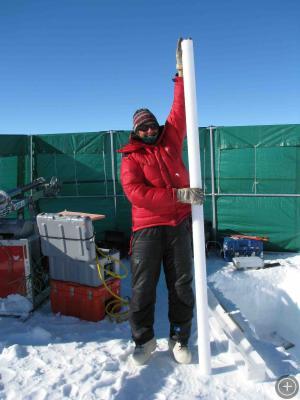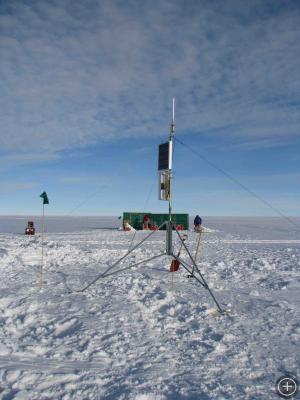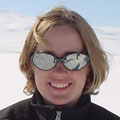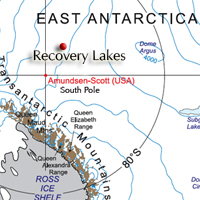Devil Snow
RECOVERY LAKES, ANTARCTICA– We’ve spent the last 3 weeks, the majority of our science days, in a region known as Recovery Lakes, or the Lake District as we affectionately call it. This system of several lakes, recently discovered, are subglacial– that is, they are below the 3000-some-odd meters of ice we are traveling over.
It is mind-boggling, I know, that there is unfrozen water that far below us, and under all that ice. The lakes are formed from heat from the earth being trapped and insulated by the several kilometers of ice and occur at the outflow of the Recovery Ice Stream, a large region of fast flowing ice.
One defining surface characteristic of the lakes is that they are flat, flat, flat, flat. There are no sastrugi [sharp frozen ridges and mounds in the snow], which we have become used to, or topography to speak of (not there was much before).
But while the landscape here is a bit monotonous, the snow here is really weird. Really weird. The top bit of snow is pretty new–some wind blown and some freshly fallen. It’s been snowing off and on while we were at camp, which is actually really rare for East Antarctica– we are in a polar desert after all. But the combined action of the wind packing the snow and changes induced by the ever-present cold temperatures and sun during the summer months have made for some of the hardest layers in the near surface I have ever encountered.
One layer, which Tom and I have been calling the MOAHL (or Mother of All Hard Layers), 1.2m deep in my pit, actually hurt my hands, shoulders and arms as I tried to dig into it with my shovel. It felt like I was trying to dig into pavement. Below the MOAHL, the snow is sugary and coarse and won’t stay together. This snow has frustrated nearly all our attempts to drill cores in it. We drill down, only to have the sugary stuff fall apart in the barrel. It’s been very exasperating– we’ve started and abandoned 10 different holes trying to get a core. I’ve started calling it Devil Snow.

Devil Snow crystals. Pretty to look at, but their rounded shapes make them not bond well to neighboring crystals, and hard to work with.
The Devil Snow is also hard to dig, falling apart on the shovel, raining down on your face and into your jacket—leaving you spitting out the coarse, sharp crystals and trying to scrape them out from your collar. It makes it hard to cut blocks out of it for the water melters, which we use for our drinking water as well. Devil Snow.
Despite the Devil Snow, we have managed to make some progress. I have dug another three pits, we have collected some shallow cores, and Lou collected one 90 m core and another 20 m core. We’ve installed a string of several temperature sensors for Ted Scambos’s graduate student Atsu in the deep hole. The temperature data is being sent via satellite to Atsu in Boulder at the University of Colorado, where he can monitor the data for changes. We already heard from him that he is receiving the data!

Lou with a monster piece of core from the Devil Snow area. The cores should be 1 m long to fit in the insulated core boxes we have, but Lou had problems getting the core out of the hole since the ice and snow is so soft. She had to keep drilling further to try to get something that she could grab onto.
Ted also installed a GPS station on the last of the lakes in order to track any changes in the level of the lake. This particular spot seemed to move up and down vertically in the last five years, as if there was a lake draining and refilling. Devil Snow or no Devil Snow, we are getting science done.
Speaking of Devil Snow, we’ve decided to start a heavy metal band called Monster Sastrugi, with the first single called Sastrugi Tongue. The other tracks on our album would be:
- Hot Raro (Raro is the New Zealand drink we have at every meal; it’s like Tang)
- Hand Core to the Transition Zone (this was Tom’s song from graduate school)
- Barrel Full of Chips (Ted thinks this song is too country-western)
- Do You Really Want to Drill Here?
- Devil Snow
- Little Cold Metal Parts
- Lost my Sprocket Wheel (luckily just once on this trip)
- Planetary Gears Rock
- Hot Differentials
- UFO Hunting in Antarctica
Of course we have, collectively, no musical talents, so there is no need to worry about the band ever producing any music– you can breathe a sigh of relief.
This brings me to another list we have been working on, the top 10 signs you’ve been on the Antarctic Plateau too long:
10. You are no longer fit for polite society.
9. Coffee consumption passes 5 cups for breakfast.
8. You expect things to go wrong.
7. -20 deg C is a “hot day.”
6. 3 meters doesn’t seem that far to dig.
5. Raro starts to taste good, and the colors are pretty.
4. When someone says they saw dragon-shaped sastrugi, someone else asks if they were Asian or fairy tale-type dragons (the answer was both).
3. You think that the piece of lint drifting across the snow is an insect, and that it would make a good pet.
2. The thought of a fresh apple makes you salivate.
And the number one sign that you’ve been on the Antarctic Plateau too long:
1. Everything is funny.












Man do I enjoy reading your dispatches Zoe. I love how you can make me just crack up laughing while simultaneously teaching me about all the different science going on, what it means, and what it’s like to be out there doing it. Best of all is that I can practically hear your voice reading it — I can hear you saying it just like you would in person. You’ve really captured your voice — congrats.
(And hope you can get out of the devil snow soon!)
All the best,
Kate
Hey Zoe,
The powder under the MOAHL sounds great…where’s your snowboard?
Can you post a picture of the whole team that is with you at some point? It’d be nice to see you all against the endless whiteness.
Also, anything to report on the dynamite front?
But Zoe, with Tom and Ted on your trip, everything IS funny!